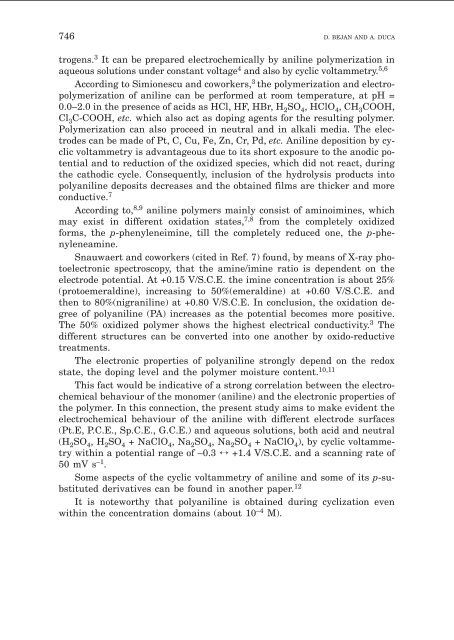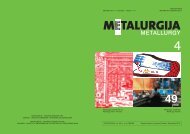Voltammetry of Aniline with Different Electrodes and Electrolytes
Voltammetry of Aniline with Different Electrodes and Electrolytes
Voltammetry of Aniline with Different Electrodes and Electrolytes
You also want an ePaper? Increase the reach of your titles
YUMPU automatically turns print PDFs into web optimized ePapers that Google loves.
746 D. BEJAN AND A. DUCA<br />
trogens. 3 It can be prepared electrochemically by aniline polymerization in<br />
aqueous solutions under constant voltage 4 <strong>and</strong> also by cyclic voltammetry. 5,6<br />
According to Simionescu <strong>and</strong> coworkers, 3 the polymerization <strong>and</strong> electropolymerization<br />
<strong>of</strong> aniline can be performed at room temperature, at pH =<br />
0.0–2.0 in the presence <strong>of</strong> acids as HCl, HF, HBr, H 2 SO 4 , HClO 4 ,CH 3 COOH,<br />
Cl 3 C-COOH, etc. which also act as doping agents for the resulting polymer.<br />
Polymerization can also proceed in neutral <strong>and</strong> in alkali media. The electrodes<br />
can be made <strong>of</strong> Pt, C, Cu, Fe, Zn, Cr, Pd, etc. <strong>Aniline</strong> deposition by cyclic<br />
voltammetry is advantageous due to its short exposure to the anodic potential<br />
<strong>and</strong> to reduction <strong>of</strong> the oxidized species, which did not react, during<br />
the cathodic cycle. Consequently, inclusion <strong>of</strong> the hydrolysis products into<br />
polyaniline deposits decreases <strong>and</strong> the obtained films are thicker <strong>and</strong> more<br />
conductive. 7<br />
According to, 8,9 aniline polymers mainly consist <strong>of</strong> aminoimines, which<br />
may exist in different oxidation states, 7,8 from the completely oxidized<br />
forms, the p-phenyleneimine, till the completely reduced one, the p-phenyleneamine.<br />
Snauwaert <strong>and</strong> coworkers (cited in Ref. 7) found, by means <strong>of</strong> X-ray photoelectronic<br />
spectroscopy, that the amine/imine ratio is dependent on the<br />
electrode potential. At +0.15 V/S.C.E. the imine concentration is about 25%<br />
(protoemeraldine), increasing to 50%(emeraldine) at +0.60 V/S.C.E. <strong>and</strong><br />
then to 80%(nigraniline) at +0.80 V/S.C.E. In conclusion, the oxidation degree<br />
<strong>of</strong> polyaniline (PA) increases as the potential becomes more positive.<br />
The 50% oxidized polymer shows the highest electrical conductivity. 3 The<br />
different structures can be converted into one another by oxido-reductive<br />
treatments.<br />
The electronic properties <strong>of</strong> polyaniline strongly depend on the redox<br />
state, the doping level <strong>and</strong> the polymer moisture content. 10,11<br />
This fact would be indicative <strong>of</strong> a strong correlation between the electrochemical<br />
behaviour <strong>of</strong> the monomer (aniline) <strong>and</strong> the electronic properties <strong>of</strong><br />
the polymer. In this connection, the present study aims to make evident the<br />
electrochemical behaviour <strong>of</strong> the aniline <strong>with</strong> different electrode surfaces<br />
(Pt.E, P.C.E., Sp.C.E., G.C.E.) <strong>and</strong> aqueous solutions, both acid <strong>and</strong> neutral<br />
(H 2 SO 4 ,H 2 SO 4 + NaClO 4 ,Na 2 SO 4 ,Na 2 SO 4 + NaClO 4 ), by cyclic voltammetry<br />
<strong>with</strong>in a potential range <strong>of</strong> –0.3 � +1.4 V/S.C.E. <strong>and</strong> a scanning rate <strong>of</strong><br />
50 mV s –1 .<br />
Some aspects <strong>of</strong> the cyclic voltammetry <strong>of</strong> aniline <strong>and</strong> some <strong>of</strong> its p-substituted<br />
derivatives can be found in another paper. 12<br />
It is noteworthy that polyaniline is obtained during cyclization even<br />
<strong>with</strong>in the concentration domains (about 10 –4 M).
















